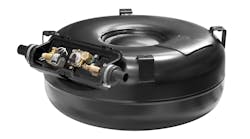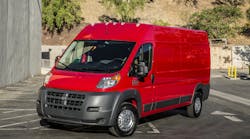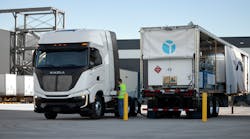Fleets in the U.S. using light duty vehicles fueled by propane autogas may not spend much time thinking about those vehicles’ fuel tanks. After all, they are usually tucked away in a pickup truck bed or under a vehicle. But that mindset may change thanks to a new fuel tank type that can help fleets run a higher performing, more profitable fleet.
Propane, also known as liquefied petroleum gas (LPG or LP gas), when used as an on-road engine fuel is called propane autogas.
The toroidal fuel tank is aptly named because it resembles the donut-shaped geometric object called the torus. Popular in Europe for many years because of the widespread use of propane autogas as a vehicle fuel there, toroidal fuel tanks were first introduced in the U.S. about a year ago.
Toroidal tanks utilize their unique shape for space efficiency. The tanks also allow for more propane autogas capacity in the same space compared with a cylindrical or twin-manifold tank.
INSTALLATION
Toroidal tanks, available in the U.S. in multiple sizes, are compliant with American Society of Mechanical Engineers (ASME) regulations. They are made of steel for durability, with a baked-on powdercoat application that maximizes corrosion resistance.
The tanks arrive ready for installation in the vehicle by propane autogas integrators, with all valves and fittings enclosed in a vapor box, along with multiple fitting adjustments so it can be easily configured for the vehicle in which it will be installed.
Toroidal tanks can be installed in many types of light duty fleet vehicles, including:
- Police cruisers or taxicabs, with installation in the spare tire area in the trunk.
- Transit vehicles, such as passenger delivery or package distribution vans, with installation, respectively, under the passenger area or the truck bed area in the rear part of the vehicle where the spare tire is typically located.
- Pickup trucks, with installation in the spare tire area under the truck bed, near the rear axle.
SPACE SAVINGS
Before the introduction of toroidal tanks, vehicle integrators specifying propane autogas system components for fleet operators typically would utilize a cylindrical tank. That’s a smart option for fleet vehicles that have to travel long distances, but what about fleet vehicles that don’t have as far to travel on a daily basis?
Take a common light duty pickup truck used by municipalities and other government entities for example.
A cylindrical tank would typically be installed behind the truck’s cab. That tank, itself, takes up to 30 percent of the truck’s bed space, meaning there is less room for tools, equipment and cargo. That may result in more than one trip from that truck’s home base to a work site to transport those things.
Conversely, a toroidal tank is installed in the spare tire area, gaining back all of the pickup’s bed space. That means all the required tools and materials can fit in the truck bed, necessitating just one trip to the work site.
SEEK ADVICE
As fleets consider alternative fuels like propane autogas, it’s important to also consider the specific components that comprise a propane autogas fuel system. Fleets should work closely with their propane autogas vehicle integrator to determine the fuel tank that makes the most sense for their light duty vehicles, based on factors like vehicle use, driving range and tank cost.
Wayne Powers is the alternative fuels general manager for Worthington Industries (www.worthingtonindustries.com), a manufacturer of fuel tanks for alternative fuel vehicles.



